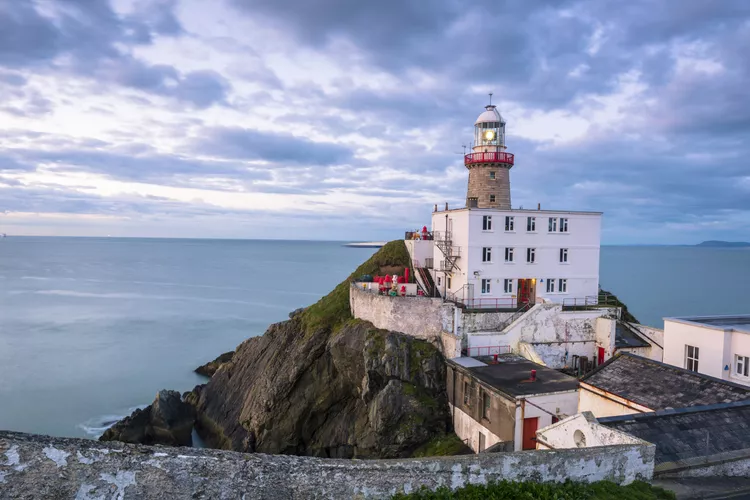Summary
Dublin’s best day trip may entail just a quick ride out to Howth, a quaint fishing village on the northern fringes of Dublin Bay. Howth boasts stunning lighthouses, a historic castle, an old abbey, and an array of great hiking trails.
Howth is the last stop on the DART line (Dublin Area Rapid Transit system) connecting the city center to the picturesque coastline. Consequently, it’s a favorite getaway for Dubliners seeking a refreshing escape from the bustling city, so the experience is enriched with the fresh sea air.
This charming town, nestled around the harbor with two long piers, promises an unforgettable day out. Howth offers a blend of natural beauty, Irish history, delightful food options, and a plethora of pubs. If you have at least half a day to spare during your Dublin visit, Howth would make for an excellent day trip.
Howth Essentials
Directions for Drivers
To reach Howth, follow the road from Connolly Station (Amiens Street) and the Five Lamps, past Bull Island into Sutton. The Sutton crossroads have signs pointing out both the direct and the scenic route — the first leads straight to Howth Harbour, while the second veers off via a longer drive crossing Howth Summit. Some parking is available at both the Summit and Howth Harbour; however, spaces might be limited, particularly on weekends. Map
Public Transport to Howth
Travelers can take the train to Howth Railway Station, the terminus for the DART service, or use a Dublin Bus, which stops at both Howth Harbour and Howth Summit. The DART is usually a faster and more efficient option.
Weather Advice
Regardless of the forecast, always pack rain gear and a pullover unless it’s a very sunny day. The winds from the sea can be cold and damp. It is advisable to steer clear of the East Pier and the Howth Cliff Path Loop trail during stormy or heavy rain conditions.
Things to See and Do in Howth
Howth is renowned for its charm as a seaside town, amiable residents, and captivating historical sites.
Baily Lighthouse, the last lighthouse in Ireland to be automated, is stunningly perched on the southeastern edge of Howth Head overlooking Dublin Bay. Established in 1814, Baily is one of Ireland’s most photographed lighthouses. The initial lighthouse was built in about 1667 by Sir Robert Reading. While direct access is not available, the cliffs present a beautiful walking opportunity in favorable weather.
While Howth Castle, erected in 1235, remains a private residence and is usually off-limits to the public, it has witnessed an “open door policy” for centuries. Thus, visitors are welcome to admire the facade, which showcases various eras of reconstruction. In spring, the castle gardens burst forth with vibrant rhododendrons. To get there, simply follow the signs for the Deer Park Hotel.
The Howth Cliff Path Loop offers a relatively safe hiking experience above Dublin Bay. This delightful walk spans approximately two hours on well-marked trails. The train station in Howth serves as the most convenient starting point, where trail markers guide you with green arrows. Be mindful that four loops commence at the station.
Howth Harbour Lighthouse safeguards the harbor entrance, characterized by its robust circular wall, which historically enclosed a gun position. As you explore the area, be sure to spot several defensive fortresses, including the Martello towers, built in the same period. The lighthouse functioned as a navigational aid until 1982 when a more modern light was established.
Howth Summit remains a favored viewpoint among visitors. Make a point to detour to the summit while in Howth for breathtaking views, and enjoy a meal at the Summit Inn, a 19th-century pub celebrated for its local seafood. Parking is available, allowing access to cliff-walking trails.
King Sitric’s Restaurant, located right on the harbor, specializes in fresh seafood delivered daily from Howth pier. The adjacent B&B offers a cozy overnight stay, where you can enjoy the soothing sounds of waves lapping at the shore.
The National Transport Museum, located at Howth Castle, showcases a diverse collection of antique vehicles, many linked to Dublin’s history. This is Ireland’s only extensive assembly of commercial and service road vehicles, including unique historical vehicles from the Dublin Fire Brigade.
Saint Mary’s Abbey, often referred to as “Howth Abbey,” originally served as a Viking holy site. These historic structures occupy a hillside in the town’s center. Access it by walking up Abbey Street, where you’ll find a narrow alley with stone steps leading uphill next to Abbey Tavern. At the top of the steps, make a right turn, and the gate to Saint Mary’s Abbey will be easy to locate. The hillside provides incredible views, along with photogenic grave sites and abbey walls.
Planning for Your Visit to Howth
Howth serves as a wonderful stop on a driving tour or a delightful multi-day retreat, such as a stay at King Sitric’s B&B. Ideally, allocate at least an hour for a brisk walk down the pier, two hours if you plan to enjoy some fish and chips, and half a day for the scenic cliff walk. For those wishing to explore the attractions of Howth thoroughly, a full day is recommended.
During summer weekends, Howth can become quite busy, which may result in challenges finding convenient parking. Weekdays tend to be calmer, making them a better option for people seeking to avoid crowds. If you dislike crowded environments, consider steering clear of bank holidays between noon and six in the evening, as Howth tends to attract many visitors during these times.
This charming seaside town can be enjoyed in any weather by dressing appropriately. It is wise to bring layers, as the wind from Dublin Bay can feel quite chilly even on sunny days. Rainfall driven horizontally by the wind will quickly soak through a light jacket, so indoor activities and cozy meals in a warm pub are great alternatives during stormy weather. When conditions are favorable, venture outside for hiking adventures by donning suitable walking gear.





